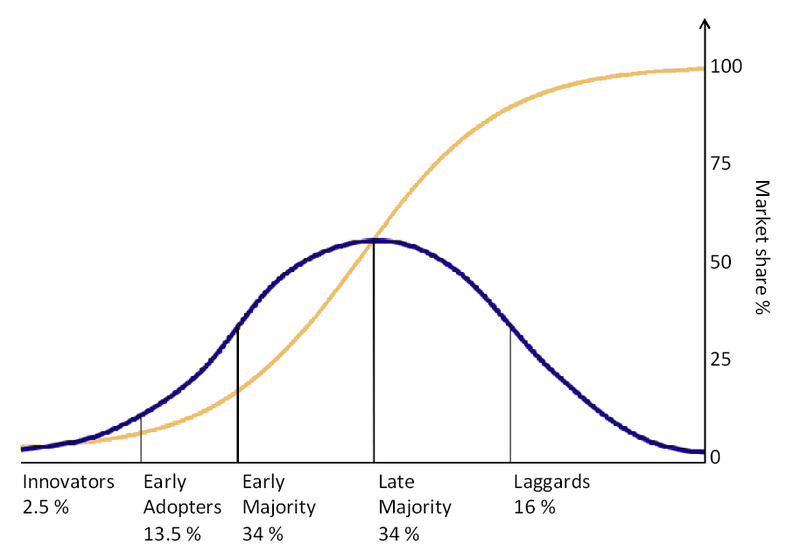Archives
The Ultrasound Market Stock Recommendation

Summary
The Ultrasound market is a ~$7B global medical systems opportunity in 2020, growing to over $10B by 2025. The market has been long dominated by expensive cart systems from GE, Siemens and Phillips at expensive price points (>$50K).
However newer disruptors in the segment of handheld systems, such as Butterfly Network are using AI and inexpensive handheld hardware ($2K + $500 annual fee) to “democratize” the use of Ultrasound for many new applications and types of users. This segment of handheld is the fastest growing at 25% CAGR.
This creates an opportunity to expand the market and fundamentally changes the landscape for Ultrasound. This is similar to how Southwest Airlines created low cost point-to-point flying, reducing costs, by doing away with many frills, thereby expanding the market and increasing the number of flyers. Or how Uber “expanded” the rides market by taking on incumbents in the taxi and limo markets by creating a market of supply by making “anyone with a car, a driver”.
Butterfly Network was founded in 2011, by Jonathan Rothberg, an industry veteran and luminary. The company has raised over $350M from multiple investors including the Bill and Melinda Gates foundation.
The company has 3 unique differentiators: a) handheld hardware (ultrasound SoC – System on Chip) with patented capability to provide 3D imaging on depth, b) strong use of Artificial intelligence for imaging analysis and c) a network of experts with content – which can now create less expensive “doctor’s aides” into ultrasound technicians.
Butterfly Network has chosen to go public on Nov 25th via a SPAC with Longview Capital ($LGVW) providing it with $584 million in cash, and valuing the company at $2B (post money). It currently trades (12/29/20) at $20.5, valuing the company at $4.17B.
This represents a 94X multiple on 2020 LTM revenue ($44M), 53X NTM revenue ($78M) and, 30X 2020 revenue ($137M). While rich, the reason could be attributed to the expected 70% revenue growth rates for 4 years (2021-2024), strong management team, unique technology, seasoned backers and disruptive market approach which could dramatically increase revenues and growth to over 100% annually for many years.
My recommendation is to initiate a long term position, with an expectation to hold for 4 years, when it will be at $235M in revenue and likely at $10B in market capitalization (42X Revenue), representing a ~139% upside in 4 years (~31% CAGR).
In 2021 I expect it to consolidate and have put a price target of $24.5 by Dec 2021, representing a 29% upside from its current price. It is likely that momentum investors will ignore the stock by Q1 / Q2 when the acquisition is complete and the stock lists as $BFLY, at which point I expect the stock to drop to between $15 – $17 per share. My recommendation is to dollar cost average (DCA) in with 25% sizing initiation by quarter or 10% every 2 weeks.
If the company delivers higher revenues that projected in its first two quarters of being public – expectations are $18 to $20M in Q1 and Q2 2021, then I would expect the stock to further gain in price to be at $30.
The biggest risks for Butterfly Network stock include a) lack of revenue growth due to insufficient trained technicians, b) an incredibly competitive landscape with over 80 other companies in the space (many with larger distribution), c) likelihood of Apple ($APPL) to enter the space with a software solution to partner with any ultrasound hardware (low likelihood), d) the very high valuation getting a significant haircut post the merger due to momentum investors moving to other pastures and e) lack of long public company operating experience making internal controls for finance, reporting and operations a material weakness.
What is Ultrasound?
Diagnostic ultrasound, also called sonography or diagnostic medical sonography, is an imaging method that uses high-frequency sound waves to produce images of structures within your body. The images can provide valuable information for diagnosing and treating a variety of diseases and conditions.
Diagnostic ultrasound is a safe procedure that uses low-power sound waves. Unlike X-Ray which might cause some radiation, Ultrasound is safe.
Ultrasound is used for many reasons, including:
View the uterus and ovaries during pregnancy and monitor the developing baby’s health, Diagnose gallbladder disease, Evaluate blood flow, etc.
How does Ultrasound work?
High-frequency sound waves travel from the probe through the gel into the body. The probe collects the sounds that bounce back. A computer uses those sound waves to create an image. Ultrasound exams do not use radiation (as used in x-rays). Because images are captured in real-time, they can show the structure and movement of the body’s internal organs. They can also show blood flowing through blood vessels.
Conventional ultrasound displays the images in thin, flat sections of the body. Advancements in ultrasound technology include three-dimensional (3-D) ultrasound (Butterfly’s market) that formats the sound wave data into 3-D images.
Ultrasound scanners consist of a computer console, video display screen and an attached transducer. The transducer is a small hand-held device that resembles a microphone. Some exams may use different transducers (with different capabilities) during a single exam. The transducer sends out inaudible, high-frequency sound waves into the body and then listens for the returning echoes.
How big is the Ultrasound market?
The Ultrasound market is expected to grow to over $10B by 2025.
Global ultrasound unit shipments grew 9% from 2016 to 2017 and totaled 218,767 in 2017. Traditional ultrasound unit shipments totaled 149,013 and accounted for 68% of the total ultrasound market in 2017. Segment growth was driven by strong demand for traditional equipment in China.
Point-of-care ultrasound (Butterfly’s market), which consists of anesthesia, critical care, emergency medicine, musculoskeletal, and primary care applications, was the smallest ultrasound segment in unit shipment terms in 2017. However, point-of-care unit shipments grew 14% from 2016 to 2017— the highest year-over-year growth rate of all three ultrasound segments.
What is handheld Ultrasound?
Sales of handheld ultrasound accounted for less than 2% of the $6.9B global markets for ultrasound equipment. The relatively high cost and limited performance of early generation handhelds were limiting factors. Steady product improvements over the years, coupled with fresh innovation from new market entrants (Butterfly), are beginning to unlock the full value of handheld ultrasound, both for experienced and new users alike.
Credentialing, data security and quality assurance (both for image capture and interpretation) can be challenging. While handheld ultrasound devices may be ready for mainstream adoption, many institutions lack the IT infrastructure required to provide seamless patient care between the office and hospital settings.
Primary care remains a largely untapped market for handheld ultrasound, and is potentially the largest opportunity, with more than 250,000 primary care physicians in the US alone.
The handheld ultrasound market is growing rapidly, as the latest generation of ultra-portable devices gains acceptance among a diverse range of customer groups, from emergency medicine physicians and internists and office-based specialists, and looking forward, primary care physicians.
The expanding customer base, coupled with the increased availability of affordable handheld scanners, is forecast to boost global sales of handheld ultrasound by over 50% in 2019. By 2023, the global market for handheld ultrasound is forecast to exceed $400 million.
Who are the key players?
While traditional players such as GE Healthcare, Siemens and Phillips matter, over 50 new companies have been funded in the last 12 years.
Butterfly Network began shipping its Butterfly iQ scanner towards the end of 2018 at the headline price of $1,999 (plus annual subscription of $420). In response, GE Healthcare cut the price of the basic version of Vscan Extend to $2,995 (currently US only).
While the price is becoming less of an issue, many primary care physicians lack formal ultrasound training and reimbursement is not widely available.
To address the lack of skills issue, vendors of handheld scanners are striving to simplify ease-of-use, both in terms of the device itself and integrated tele-ultrasound services that connect novice users with experts at separate locations over two-way audio and video calls.
The latest generation of handheld scanners feature numerous presets for common exam types and artificial intelligence (AI) is being applied to enable physicians with no prior scanning experience to capture high-quality images.
AI-guided ultrasound will help users to identify body parts and correctly position the transducer to maximize the image quality for a given exam. Moving forward, AI will also play an increasingly important role in image interpretation, providing physicians with automated measurements, anomaly detection, and diagnostic decision support.
What is the customer problem?
For patients who do not want exposure to radiation (X-ray) and need a quick convenient way to view internal organs for issues, Ultrasound is the best solution.
For example, ultrasound is playing an increasingly important role as a screening tool for women with dense breast tissue. In acute care, ultrasound is increasing being used for lung imaging to diagnose conditions such as pleural effusion, pulmonary oedema and pneumothorax.
In another example, the use of shear wave elastography is expanding beyond hepatology (e.g. liver fibrosis) to other body areas, including breast, prostate, thyroid and spleen. Musculoskeletal is another relatively untapped market for ultrasound, including orthopedics, rheumatology and sport’s medicine.
Who is Butterfly?
Butterfly Network, Inc. (“Butterfly”) is the inventor / pioneer in semiconductor-based point-of-care ultrasound (“POCUS”) devices
Founded in 2011 by visionary innovator Jonathan Rothberg. Dr. Jonathan Rothberg PhD, Founder and Chairman, has dedicated his career to enabling breakthrough technologies to revolutionize healthcare. He was given several awards including from President Obama to further the cause of better healthcare.
Total investment of over $400 million with first product introduced in 2018, 700+ patents and 2020E revenue of $44 million, projected to grow to $138 million in 2022E.
Longview Acquisition Corp. (“Longview”) is a Special Purpose Acquisition Corporation (“SPAC”). Initially capitalized with $414 million in cash in May 2020.
Butterfly develops a sensor and software to enable handheld Ultrasounds.
400-member team.
What is unique about Butterfly? What is their moat?
There are 3 parts to Butterfly:
- A 3D patent pending rendering sensor with System on Chip
- AI and software to make it easier for diagnosis without significant training.
- Strong content and delivery network to train new specialists and “less expensive” technicians.
Who are the competitors?
As mentioned over 100 companies old and new startups exist in the space. Butterfly is the most funded, the earliest and has the most patents among the smaller upstarts.
Why will Butterfly win over others?
- Funding: Better funded ($400M to date, plus $453M from the SPAC IPO)
- Sensor technology: Proprietary SoC with hundreds of patents on the sensor
- Distribution: Strong distribution framework for new applications
- Software and AI: AI and machine learning software to make it easier for technicians to diagnose problems
- Support: Strong training and support network
- Competitive Price: Superior price point (under $2000) plus annual fees (subscription)
- Talented management team: with CEO who has experience in managing fast growing companies.
Artificial intelligence (AI) will have a transformative impact on the market as it addresses some of the key limitations associated with ultrasound; namely, the shortage of trained sonographers and the relatively steep learning curve, high operator dependency both during image acquisition and interpretation, poor image quality for certain exam types and the relatively lengthy exam time compared with other modalities.
The first wave of ultrasound AI applications are entering the market and are mainly for image optimization (noise reduction) and automation of time consuming and repetitive tasks, such as anomaly detection, image labelling, feature quantification and classification.
However, the greatest impact of AI will be guided ultrasound (ultrasound navigation), which will provide real-time support during image acquisition (i.e. probe placement and anatomy detection). This is what Butterfly does best.
What are the financial projections?
Butterfly is expected to grow at over 60% in 2020 from 2019 and over 77% for the next 2 years to reach $138M in 2022.
Why is the valuation of Butterfly so rich?
Given the rich background, the lack of multiple companies that are public in the space and execution record, Butterfly is very highly priced. It does have strong projections of growth in revenue to back the valuation.
Archives
What If You Were Given 10x The Amount Of Money You Wanted To Raise?

I had an interesting discussion with an entrepreneur friend yesterday. She has a consumer Internet (Curated marketplace) startup, which she has been working on since Jan. She soft launched it in May and has been seeing a doubling of revenue every 2 weeks so far. She is on the fund raising circuit and has a few interested people.
After a quick 30 min on her market segments, the traction and her supplier base, I was very keen to invest myself. She’s a very talented entrepreneur and passionate engineer, so I was a little concerned that she did not have anyone from the domain on her team. So, I demurred, asking her to connect with a few other folks I invest with.
One of the investors I talked to asked me how much she was looking to raise. I mentioned she was looking for about $500K.
“Why not $5 Million and go big”? was his question.
I started to offer some “rational” arguments as to why not – first, she did not have enough traction to justify a $8 – $10 Million valuation, she would not know what to do with the money, she was still trying to form her team, but I was thinking at the back of my head – “What if’?
What if investors did give you 10X the money you were asking for?
I understand that’s rare and largely impossible for most entrepreneurs to get, but what if?
So, I did a quick thought experiment with my entrepreneur friend and asked her to think, but not spend too much time modelling what her investments and metrics would be at $5 Million invested in the company.
At first, she was excited and said she could use all that money to hire people, expand into SF and other cities, etc.
A good 15 minutes later, she called back, much sober and asked – what % of the company would she have to give up for that kind of money – I said I did not know but suspected it would be 60-70% at this stage given the risk. Maybe if she was lucky, 50%. Again, I did not know, but I doubted that she would be able to get away with less.
After 30 more minutes, she called again, now asking me for the metrics that she’d have to hit. I thought she would not ask me that question, but I am glad she did. As an investor I wanted to have 5X to 10X return in 18-24 months, so I said she’d have to be at $50 Million to $100 Million valuation within 18-24 months.
She was doing $1000 per month. Even if we gave her a rich valuation, she’d have to be at $2 – $3 Million revenue per month in 18 – 24 months I thought.
She then pulled back.
Nope, she said. She was happy with raising $500K. Much less money, much more control, but much less stress.
I think we learned a lot from this thought experiment.
What would you do?
I dont think there’s a single person who would not expect more money (as investment) to mean more stress, but that’s the nature of the business.
You can work your way into it, or work towards your goal. Either ways, it is a lot of work.
Archives
The “two Speed” State Of Indian Market Adoption

I have been watching / following 7 startups (3 in eCommerce, 2 in SaaS and 2 in consumer Internet) that target the Indian market over the last 14-18 months. All the entrepreneurs approached me with an intent to get seed funding so I had a chance to go over their traction, progress and future projections.
I have formulated a theory of market adoption of products / high technology products in India which I have tested with these and other companies and also with several venture investors.
For background please read “Diffusion of innovations” by Everett Rogers and Crossing the chasm by Geoffrey Moore. Don’t worry, I have only linked to their Wikipedia page, so it wont cost you anything.

At the top of the consumption (and monthly income) pyramid in India are what economists and marketing people call the SEC A and B class who have enough disposable income to spend on innovative new products. For the purposes of this blog post I am going to use 10 Mill (SEC A) + 20 Million (SEC B) households as the target.
The Innovators (less than 1 % of the population or 12 Million individuals) in India (entrepreneurs mostly) who conceive and develop these products for the Indian market and the early adopters (less than 5% of population or approx 60 Million individuals) together make up the entire “early adopter” category. Unfortunately less than 30% of them have both the interest, and the desire to be early adopters of technology.
Indian markets do not follow traditional diffusion characteristics when first innovators buy, then early adopters, then the early majority, and then the late majority and finally the laggards.
My theory on how diffusion of innovations works in the Indian context is as follows.
In India there are only 2 market adopters – those that are early and those that are not.
Abhijeet calls it the “low hanging fruit” and then everyone else.
So lets look at the implications of this observation / theory.
So what does that mean for entrepreneurs?
You will see a “headfake” of adoption and then a taper off.
E.g. The B2B SaaS company will quickly (within 3-6 months) get 10+ customers and over 30 in the pipeline, only to find the next 50 and the next 100 or the next 1000 are either non-existent or will come in 3-6 years.
E.g. The eCommerce company will see 1 -3 Million “registered” users and 1000’s of transactions within 12 months and find that the next 1000, 5000 and 10,000 transactions take 4-5 times as long.
E.g. You will see an initial 20,000 users for your mobile application for social TV extremely quick (within 3-6 months) and the next 50,000 or 100,000 take you the next 3-6 years.
I have seen these numbers play out again and again to know there are exceptions but those are rare.
These numbers are also dramatically different than those of companies targeting US or other markets.
When should you (as the entrepreneur) raise money?
You should raise it at the peak of inflated expectations. I.e. After you have some traction, which the investors think will be long lasting, steady and rapid. You will get the best valuation for the company at that time. Once your investor has some “skin in the game”, they are in to get their money back and then some, so they will do all it takes to make you successful.

What does this mean for investors?
The best time to invest is either very early (starting to build a company, idea and team stage) OR at the trough of disillusionment stage.
If they are early, you will get the bump from the initial adoption, so the value of the company increases many fold before the next round (which you should help the company raise at the peak of inflated expectations.
If you are post the trough, then you benefit from a growth stage.
What makes you go over the trough to the slope of enlightenment?
In my experience:
TIME
Nothing else.
You may think I am being facetious, but I am serious.
This may be a cultural thing, but in India, over time if you have the ability, patience and willingness to survive, you will reach the plateau of productivity.
Anecdotal evidence over several sales transactions also suggests to me that once people in India see you around for 2-3 years, they think “Okay, this company / person is for real. We should give her / the product a shot”.
Big thanks to Abhijeet and Shekhar for helping me with their data points to reinforce my theory.
Read Also: The Indian Startup Ecosystem Should Look At Israel As A Role Model
Archives
The Coming 20+ Year Disruption In Higher Education

This is a post on the problems & solutions in higher education from someone clearly not qualified to make those observations. The only information I have is the 79 pitches from entrepreneurs large and small who are all trying to disrupt Higher Education from around the world. Besides that over 500+ articles, blog posts & discussions with several professors at the top colleges in the world.
The Higher Education market is largely a US dominated one. With over 4500 private, public and semi-public colleges and universities, this market is over $475 Billion. Over 9% of US GDP and close to $1.3 Trillion (pdf) is spent on education overall. While there is more spent on K-12 education, the higher ed market has more spend per student.
Most of the money spent by students in on tuition. Over 57% of the higher ed spend is on tuition. This goes towards educators, libraries, textbooks, facilities, etc.
The average 4 year college cost is reaching $30K+ per year for private colleges. Given that over 70% of US students end up with over $30K in debt after college, this clearly unsustainable.
With the advent of MOOC (Massive Online Open Courses) I personally believe it is only a matter of time before many of the 4500 colleges shut down. I personally think 50% of colleges in the US will close down in 10+ years. Similar for Indian colleges – over 50% of colleges in India will shut down in 20 years.
Most private colleges make money from endowments, grants, and then from tuition – in that order. Most of the moneyed institutions have “rich” students who then become alumni and donate to the college, many of the smaller colleges dont.
The average private college takes 2000+ students and charges about $30K per student. Lets say that is $60 Million per year.
Now imagine that the private college wants to take 20,000 students (online) instead. [They could also take 100,000 students, since nothing is going to stop them from doing that]. All things being equal and factoring in inflation, and the cost to run the university being largely the same, they would be able to charge $3K per student per year and still do well.
It is not a dream. It is going to happen. In 10-20 years, or likely sooner, but it is going to happen.
Would you rather get a degree from MIT and be taught by the top professor at MIT or a local college professor who may not have the level of depth and knowledge about the subject as the MIT professor?
You can do this from Saudi Arabia, Australia and India. That’s because even the folks in Newton, Mass, who live <100 Miles from MIT will be doing the same.
Most learning is going online. In a massive way. Higher education is as well.
Now, I understand the concerns.
A) The Internet do not replace the interaction you get in a face-to-face setting.
B) How can you build relationships with your students and network with them – which is the biggest value of a college 10 years hence? and
C) Online learning is still largely unproven.
All that will get itself sorted out with other offerings to supplement the MOOC.
In the future you will have interactions (office hours) remotely managed by professors.
In the future you will learn from your peers together as much as you will from the professor – which will build the relationships.
In the future you will have more teaching aids and tools to help you sort, identify and collate your learning better than textbooks.
That future is less than 10 years away.
I am going to shift gears and now try to talk to future parents.
What should you do? What are the things you can do to make sure your kids are going to be successful? This is primarily if your kids are between 0-10 years old.
First and (I cannot understate this) let your kids find their way.
If you can make the investment, buy them a tablet and let them learn stuff using the machine.
If you can get them to follow structure courses online (for older kids), I’d recommend Khan academy and other sites like those.
We dont have Television at home, but I am not convinced that’s the right approach for everyone. If you can get rid of the television, do it. I’d highly recommend it.
Kids will play more games than use the tablet for useful stuff initially but that novelty wears off in a few years. The % of core gamers and those that are addicted to gaming is still small. I am not saying ignore it, but be less worried about that than no exposure to games at all.
I dont think most parents will give up the school environment all together, since they need the kids to be “someplace” other than home when they head to work, but I would focus a lot less on grades at school.
In fact, grades will become irrelevant in 15 years, increasingly replaced by “show me what you did” instead of “how did you learn”. Why?
If you are MIT or Stanford and you want 20K students to take your course, you are likely to get less picky a decade from now.
[Side note: Similar to startups these days, when being evaluated by investors, the focus is on product & traction, not on idea, grades tell me how you studied, not what you learnt].
The goal of these colleges will go away from “exclusivity for some” to “knowledge for all” very soon. That’s the direction they are all heading. Will MIT as an institution or the lecture halls go away? – not likely. They will be the purview of the few rich kids who can spend $100K per year to be housed in 5 star luxury comforts. For the rest of us, a computer and an internet connection will suffice.
This next paragraph is going to unsettle a few folks, but hear my argument.
Focus on spending money *now* to help your kids, than saving money for the future. Most parents I know end up trying to save for education – by putting money in 529 plans, education savings plans and the like. I would use as much money you plan to save for the future into their education right now. Give them any edge they can get now and you will end up spending 1/3rd of what you originally planned for later.
That’s because the cost of higher education is going to drop dramatically for most students.
So who will hurt from these disruptions?
1. University deans, college presidents and the endowment chairs, who make over $1 Million per year.
2. Smaller unknown colleges who will see their enrollments drop dramatically and will likely have to shut down.
3. 529 plan administrators.
For the rest of us, quality higher education is going to be highly accessible.
Also Read: 5 Steps To A Good Market Analysis For Your Startup
-

 Business5 days ago
Business5 days agoWhat I Learned in My First Month of Running a Startup Accelerator
-

 Business3 weeks ago
Business3 weeks ago5 Profitable Digital Business Ideas, Increase Your Income!
-

 Archives3 months ago
Archives3 months agoHow Can You Tell If An Angel Investor Is “real” Or “fake”?
-

 Business1 month ago
Business1 month agoIndividually Proficient, Collectively Efficient; Why Your First Hire Matters
-

 Business3 days ago
Business3 days ago6 Affordable Co Working Space around the Globe
-

 Business3 days ago
Business3 days ago6 How to Make a Business Presentation More Relatable
-

 Archives1 month ago
Archives1 month agoHow Accelerators Make Money To Manage Operating Costs
-

 Politics1 month ago
Politics1 month agoPrediction of Global Economy in 2024, How’s Indonesia?











